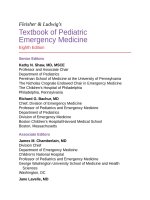Pediatric emergency medicine trisk 1475 1475
Bạn đang xem bản rút gọn của tài liệu. Xem và tải ngay bản đầy đủ của tài liệu tại đây (131.06 KB, 1 trang )
child with a retropharyngeal abscess who presents with a high fever, toxic
appearance, and torticollis is sometimes incorrectly suspected to have meningitis.
A soft tissue lateral neck radiographic examination may demonstrate the lesion,
whereas direct visualization is often impossible. Unfortunately, flexion (even
limited) of the neck during the radiograph may cause a buckling of the
retropharyngeal tissues that resembles a purulent collection. The clinician must
insist on a radiograph with the neck fully extended before hazarding an
interpretation. If the diagnosis remains uncertain despite adequate radiographs, a
computed tomography (CT) scan with intravenous contrast should be obtained.
TABLE 74.2
COMMON CAUSES OF SORE THROAT
Infectious pharyngitis
Respiratory viruses
Group A streptococci
Epstein–Barr virus
Irritative pharyngitis
Forced hot air heating
TABLE 74.3
LIFE-THREATENING CAUSES OF SORE THROAT
Retropharyngeal and lateral pharyngeal abscesses
Epiglottitis
Tonsillar hypertrophy (severe) with infectious mononucleosis
Diphtheria
Peritonsillar abscess
Lemierre syndrome
Lateral pharyngeal abscesses manifest in a fashion similar to retropharyngeal
infections but occur less often. High fever is a common symptom, and both
trismus and swelling below the mandible may be seen. Lateral neck radiographs
are often unrevealing, with no appreciable thickening in the prevertebral space. A
CT scan helps to confirm the diagnosis.
The Children’s Hospital of Philadelphia Clinical Pathway









